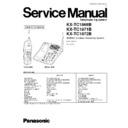Panasonic KX-TC1868B / KX-TC1871B / KX-TC1872B Service Manual ▷ View online
10.2.1. TDD Frame Format
The TDD frame is 2mS in length, and is composed of two symmetrical 960 µS TX and RX subframes. Each subframe contains 96
bits of 10µS duration, with 40µS guard times between both TX and RX subframes.
bits of 10µS duration, with 40µS guard times between both TX and RX subframes.
Each subframe consists of the following four fields:
•
A 16-bit Preamble field
•
An 8-bit Data Channel field
•
An 8-bit Sync Word
•
A 64-bit ADPCM Payload
10.3. Spread Spectrum
Transmission and reception are operated using the spread spectrum method.
DSS (Digital Spread Spectrum)
Mixing the original signal with the pseudo random noise code (PN code) works the spread spectrum. In this system PN code is 15
chip. Although the band width is spread fifteen times, the power level per cannel becomes lower.
chip. Although the band width is spread fifteen times, the power level per cannel becomes lower.
Fig. 8
41
KX-TC1868B / KX-TC1871B / KX-TC1872B
10.4. Signal Flowchart in the Whole System
Reception
CN101 of the base unit is connected to the TEL line, and the signal is input through the bridge diode D101. While talking the
relay (Q121) is turned ON and amplified at the amplifiers Q461, then led to DSP (IC501). DSP generates ADPCM signal. The
ADPCM signal is input to RFIC (IC101) of RF UNIT, and is mixed with pseudo random noise code (PN code) to spread the
spectrum. RFIC outputs FSK modulated RF signal. The RF signal is passed through the balun (T101) and filter (F102) to be
transmitted from the antenna. As for the handset, RF signal from the antenna is input to RFIC passing through filter (F102) and
the balun (T101) to perform the de-spread, then input to DSP (IC201). DSP performs ADPCM decoding to convert the signal
into the voice signal, then it is output to the speaker.
relay (Q121) is turned ON and amplified at the amplifiers Q461, then led to DSP (IC501). DSP generates ADPCM signal. The
ADPCM signal is input to RFIC (IC101) of RF UNIT, and is mixed with pseudo random noise code (PN code) to spread the
spectrum. RFIC outputs FSK modulated RF signal. The RF signal is passed through the balun (T101) and filter (F102) to be
transmitted from the antenna. As for the handset, RF signal from the antenna is input to RFIC passing through filter (F102) and
the balun (T101) to perform the de-spread, then input to DSP (IC201). DSP performs ADPCM decoding to convert the signal
into the voice signal, then it is output to the speaker.
Transmission
The voice signal input from the microphone is led to DSP (IC201). The DSP generates ADPCM signal. As well as the reception,
it is converted into the RF signal by RFIC (IC101). Passing through the balun (T101) and filter (F102), it is transmitted from the
antenna. As for the base unit, RF signal from the antenna is input to RFIC (IC101) passing through filter (F102) and the balum
(T101) to perform the de-spread, then input to DSP (IC201). DSP performs ADPCM decoding to convert the signal into the
voice signal. The voice signal is amplified at the TX amplifier (Q131), then output to the TEL line (CN101) through the relay
(Q121) and bridge (D101).
it is converted into the RF signal by RFIC (IC101). Passing through the balun (T101) and filter (F102), it is transmitted from the
antenna. As for the base unit, RF signal from the antenna is input to RFIC (IC101) passing through filter (F102) and the balum
(T101) to perform the de-spread, then input to DSP (IC201). DSP performs ADPCM decoding to convert the signal into the
voice signal. The voice signal is amplified at the TX amplifier (Q131), then output to the TEL line (CN101) through the relay
(Q121) and bridge (D101).
42
KX-TC1868B / KX-TC1871B / KX-TC1872B
10.5. EXPLANATION OF BBIC DATA
COMMUNICATION
10.5.1. Calling
10.5.2. To Terminate Communication
10.5.3. Ringing
43
KX-TC1868B / KX-TC1871B / KX-TC1872B
11 TERMINAL GUIDE OF IC´S, TRANSISTORS AND DIODES
11.1. Base Unit
11.2. Handset
44
KX-TC1868B / KX-TC1871B / KX-TC1872B
Click on the first or last page to see other KX-TC1868B / KX-TC1871B / KX-TC1872B service manuals if exist.

